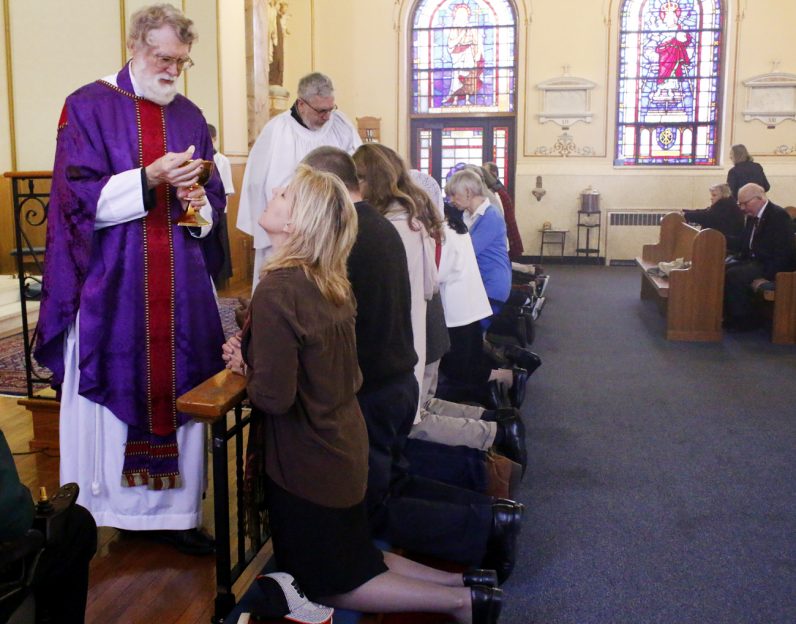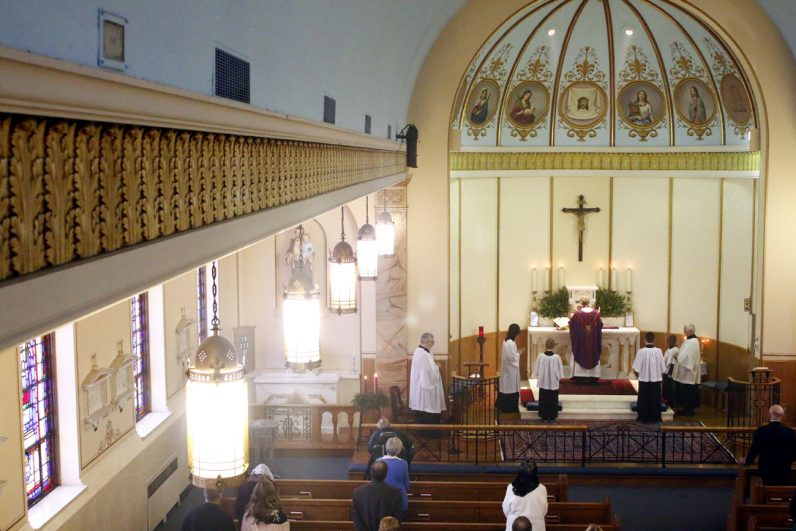
Father David Ousley distributes holy Communion at the altar rail at St. John the Baptist Church for his congregation of former Anglicans and Episcopalians who are in communion with the Catholic Church under a personal ordinariate establish by the pope in 2012. (Photo by Sarah Webb)
St. John the Baptist Catholic Church in Bridgeport, which will joyfully celebrate its first anniversary Dec. 18 on the fourth Sunday of Advent, is unique among Catholic parishes in the Philadelphia area.
It is not part of the Archdiocese of Philadelphia, nor is it one of the Eastern-rite Catholic churches in full communion with the Holy See with parishes within the five-county area.
St. John’s is part of the Houston-based Personal Ordinariate of the Chair of St. Peter within the Roman Catholic Church, which was established in 2012 by Pope Benedict XVI. It was one of three such ordinariates established (the other two are in England and Australia) to serve the spiritual needs of former members of the Anglican Communion, including Episcopalians, who wish to the reunite with the Catholic Church.
(See a related video.)
St. John the Baptist Parish was formed through the merger of two smaller local congregations that broke away from the Episcopal Church because of concerns about changes within their denomination: St. Michael the Archangel, which worshiped in Philadelphia’s Mount Airy section and Blessed John Henry Newman, which worshiped in Wayne.
Last year the St. John’s community arranged for a lease to purchase the former Our Lady of Mount Carmel Church, an Italian personal parish in Bridgeport, which had merged into Sacred Heart Parish in nearby Swedesburg in 2014.
[hotblock]
Father David Ousley, the pastor of St. John the Baptist, expects arrangements for the purchase will be finalized in the near future. His congregation, which has about 100 members, is financially stable and he expects further growth.
“Our primary focus is Catholicity for Anglicans who see a need for it,” he said. “Usually they see a need for the sacraments or the need for sound and concrete teaching.”
(See a photo gallery from Mass at St. John’s on Sunday, Dec. 11, here.)
Father Ousley himself was ordained as an Episcopal priest in 1979, but he and his wife Elizabeth and three children were received into the Catholic Church along with some members of his former parish. He was ordained a Roman Catholic priest in 2012.
At this point, Father Ousley estimates, there are about 75 priests in the Ordinariate serving 43 congregations in the U.S. and Canada, and there are 4 seminarians.
Most of the priests who were previously ordained in the Anglican Communion are, like Father Ousley, married men, but any future candidates for the priesthood must be single, as the rule of celibacy will generally be observed.
Following the general practice in the Eastern Catholic Churches and Orthodox Churches, married priests may not become bishops.
The Mass at St. John the Baptist, as celebrated by Father Ousley, is quite different from Masses most Catholics are accustomed to. At first glance is may seem similar to a Tridentine Mass, for example the celebrant faces East to the altar not to the congregation and there is an altar rail separating the priest and the people.
Unlike the Tridentine Mass it is celebrated in English, not Latin. With modifications, the Missal used for the liturgy descends from the Anglican Missal adopted in England in 1549 during the short reign of “the boy king,” Edward VI, the son of Henry XIII, a decade before the Council of Trent concluded.
Because of its age, the liturgy reflects the grandeur of the vernacular English of that era, and the Ordinariate has retained many of the beloved hymns traditionally sung by Anglican and Episcopalian congregations.
[hotblock2]
Music has always been valued in the Anglican Communion and at St. John the Baptist, where the weekday low Masses may be complete in a half hour or so. The Sunday liturgy, which is a sung Mass, which might take an hour and a quarter. Technically it is not a high Mass because that form also requires an ordained deacon and subdeacon (a lector at this point).
Father Ousley does have two men in formation at this time and he expects at a future date there will be High Masses.
Who are the people who worship at St. John the Baptist? Most, like Father Ousley, are former Episcopalians or Anglicans and their family members. Others are converts and still others are Catholics who choose to worship there, but cannot be formal members of the parish.
Wherever they come from and for whatever reason, they are part of the one, holy, Catholic and apostolic Church and its rich diversity, in this case receiving their spiritual sustenance through the Personal Ordinariate of the Chair of St. Peter.
PREVIOUS: 5,000 pounds of food from Goya will feed hungry families
NEXT: In Advent, the faithful pray special prayers at Mary’s shrine




Share this story